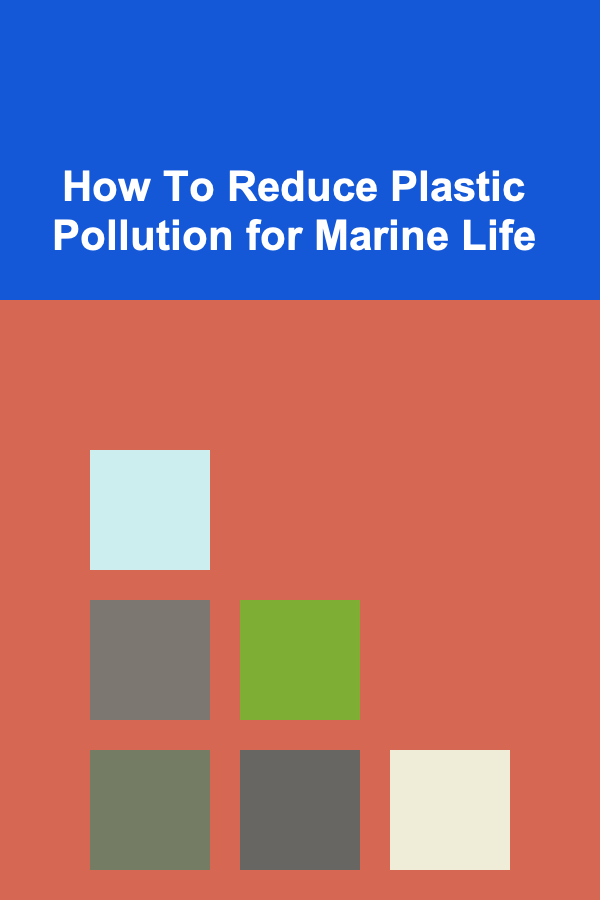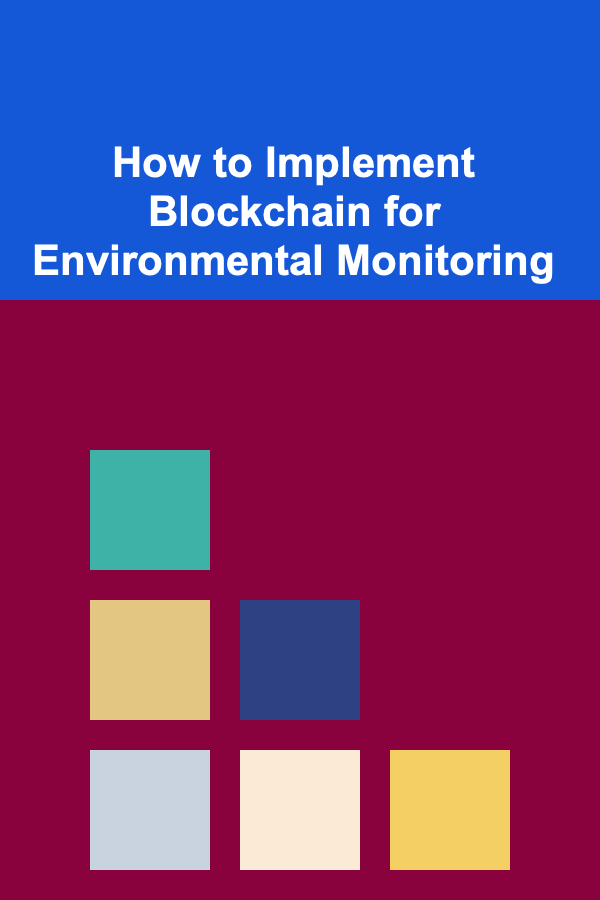
How To Reduce Plastic Pollution for Marine Life
ebook include PDF & Audio bundle (Micro Guide)
$12.99$6.99
Limited Time Offer! Order within the next:

Plastic pollution has become one of the most pressing environmental challenges of the 21st century. With its widespread use and slow decomposition rate, plastic has permeated every corner of our planet. Of particular concern is the devastating impact of plastic waste on marine life. As plastic debris enters our oceans, it endangers countless species, disrupts ecosystems, and threatens the health of our oceans. This article explores the severity of plastic pollution in marine environments and outlines strategies to reduce plastic pollution for the sake of marine life.
The Scope of the Problem
Plastic pollution in the oceans is no longer a distant threat---it is a reality. An estimated 8 million tons of plastic waste enter the oceans every year, according to a 2015 study published in Science. The problem has escalated over the past few decades, and the scale of its impact is vast. Plastic is used in an array of products from packaging, single-use items, to industrial goods. Once discarded, plastics often end up in rivers, which carry them into the sea, where they persist for centuries.
There are two main types of plastic debris in the ocean:
- Macroplastics: Large pieces of plastic, such as bottles, bags, and fishing nets, that can be visibly seen floating on the surface or washed up on shorelines.
- Microplastics: Tiny plastic particles (less than 5mm in size) that result from the breakdown of larger plastic items. These microplastics are often found in the water column and are easily ingested by marine organisms.
Plastics do not biodegrade like organic materials. Instead, they photodegrade, breaking down into smaller pieces over time due to sunlight exposure. However, the smaller particles remain in the environment, accumulating and harming marine life, making plastic a long-term pollutant.
The Impact of Plastic Pollution on Marine Life
2.1. Ingestion of Plastic
Many marine species, including fish, seabirds, and even whales, mistake plastic for food. For instance, sea turtles are often found with plastic bags in their stomachs, mistaking them for jellyfish, their natural prey. When consumed, plastic can block the digestive tract, leading to malnutrition, starvation, and even death. Additionally, plastic particles can leach harmful chemicals into the stomachs of marine animals, affecting their overall health.
Marine mammals, like seals and dolphins, are also vulnerable to ingesting plastic. Small plastic pieces, or microplastics, are often mistaken for plankton or other food sources, entering the food chain at the base level and accumulating as they move up the trophic levels. This accumulation can lead to poisoning in apex predators, including humans, who may consume contaminated seafood.
2.2. Entanglement
Apart from ingestion, plastic debris also poses a threat through entanglement. Discarded fishing nets, plastic ropes, and other forms of plastic waste can entangle marine animals, causing injury or death. Sea lions, turtles, and seabirds are particularly prone to becoming ensnared in discarded fishing gear, which often leads to slow, painful deaths. Entanglement can cause physical injuries, impair movement, and prevent animals from feeding or reproducing.
2.3. Habitat Destruction
Plastic pollution also has a destructive impact on marine habitats. Coral reefs, which are home to a vast array of marine species, can be smothered by plastic debris. When plastic waste is trapped in coral reefs, it blocks sunlight and prevents the delicate polyps from photosynthesizing, weakening the entire ecosystem. Furthermore, plastics can release toxic chemicals, contributing to coral bleaching and further threatening biodiversity.
Similarly, coastal ecosystems like mangroves and wetlands are not immune to the effects of plastic pollution. These habitats are essential for the protection and breeding of marine species. When plastics accumulate, they disrupt the ecological balance, suffocating plant life and harming animals that depend on these areas for shelter.
2.4. Chemical Pollution
Plastics often contain harmful chemicals that leach into the environment. These chemicals include additives used to make plastics more flexible, durable, or colorful, as well as pollutants that attach to the surface of plastic debris. When marine creatures ingest plastic, they inadvertently ingest these toxic substances, which can disrupt their hormonal systems, damage their organs, and increase the risk of cancer. Furthermore, the chemicals from plastics can enter the food chain, ultimately affecting human health.
Strategies to Reduce Plastic Pollution for Marine Life
Given the overwhelming threat that plastic pollution poses to marine life, it is essential to take immediate action. The following strategies outline practical measures that governments, industries, and individuals can take to reduce plastic pollution in our oceans and protect marine ecosystems.
3.1. Policy and Legislation
One of the most effective ways to combat plastic pollution is through the implementation of stringent policies and regulations. Governments can introduce policies aimed at reducing plastic waste and promoting alternatives. Some of the key legislative measures include:
- Plastic Bans and Restrictions: Many countries and cities have already implemented bans on single-use plastic items such as straws, bags, and utensils. Expanding these bans to include other items, such as plastic packaging, can significantly reduce the amount of plastic entering the oceans.
- Extended Producer Responsibility (EPR): EPR programs hold manufacturers responsible for the entire lifecycle of their products, including disposal. This creates an incentive for companies to design products that are easier to recycle or are made from more sustainable materials.
- Deposit Return Schemes: These schemes, where consumers pay a deposit on plastic bottles and receive a refund when they return them for recycling, have been shown to increase recycling rates and reduce littering.
- Plastic Waste Export Restrictions: Some countries send their plastic waste to other nations for disposal or recycling, often to regions with inadequate waste management systems. Banning or limiting the export of plastic waste can prevent it from ending up in less regulated environments.
3.2. Innovations in Material Science
While reducing plastic use is essential, it is equally important to develop alternative materials that are biodegradable and environmentally friendly. Research into sustainable materials, such as plant-based plastics, algae-based products, and biodegradable packaging, is critical. These alternatives can help reduce the environmental impact while still serving the same purposes as traditional plastics.
For instance, bioplastics made from corn starch or sugarcane are already in use for packaging and single-use items. These materials break down more quickly than petroleum-based plastics, posing less risk to marine life. However, these alternatives should be tested to ensure that they do not release harmful substances when exposed to marine environments.
3.3. Improved Waste Management
Many plastic items end up in the ocean due to poor waste management systems. Effective waste management, particularly in countries with high waste generation, is crucial to reducing plastic pollution. Strategies for improving waste management include:
- Increasing Recycling Rates: Governments and private companies must invest in better recycling infrastructure. This includes making it easier for consumers to recycle, creating incentives for recycling, and improving the efficiency of sorting and processing recyclable materials.
- Waste-to-Energy Technologies: In cases where recycling is not feasible, waste-to-energy technologies can be used to convert plastic waste into energy, reducing the amount of plastic that ends up in landfills or the ocean.
- Education and Awareness: Public education campaigns can raise awareness about proper disposal methods and the consequences of plastic pollution. Teaching people about the importance of recycling, reducing consumption, and proper waste disposal can significantly reduce plastic waste at the source.
3.4. Marine Clean-Up Initiatives
Efforts to clean up plastic waste from our oceans are critical to mitigating the impact of plastic pollution on marine life. Several initiatives have emerged in recent years to address this issue, including:
- Ocean Cleanup Projects : Organizations like The Ocean Cleanup are working to develop innovative technologies that can remove plastic waste from the ocean. These technologies use floating barriers to collect plastic debris, which is then removed and recycled.
- Beach Clean-Ups: Community-led beach clean-up events are a practical way to remove plastic waste from coastal areas. These events help raise awareness of the issue and engage local communities in the fight against plastic pollution.
- Seafloor Cleanup: Plastic waste also accumulates on the seafloor, where it can be difficult to remove. Specialized equipment is being developed to recover plastic waste from the ocean floor, helping to reduce the environmental damage caused by plastic in deeper marine ecosystems.
3.5. Individual Action
While large-scale policy changes and innovations are essential, individual actions also play a crucial role in reducing plastic pollution. Some simple steps individuals can take include:
- Reducing Plastic Consumption: Choosing reusable products, such as cloth bags, stainless steel bottles, and metal straws, can significantly reduce the amount of plastic waste produced.
- Supporting Eco-Friendly Companies: Consumers can choose to support businesses that prioritize sustainable practices, such as those that use biodegradable packaging or have a commitment to reducing plastic waste.
- Advocating for Change: Individuals can advocate for stronger plastic regulations by contacting lawmakers, participating in environmental campaigns, and supporting organizations working to reduce plastic pollution.
Conclusion
Plastic pollution is one of the most significant environmental challenges facing our oceans and marine life. The effects of plastic on marine species are devastating, from ingestion and entanglement to habitat destruction and chemical contamination. However, by adopting a combination of policy measures, technological innovations, improved waste management practices, and individual actions, we can significantly reduce plastic pollution and protect marine ecosystems.
While progress is being made, the scale of the problem requires urgent and collective action. Protecting marine life from plastic pollution is not just an environmental issue---it is a moral and economic one. Our oceans and the creatures that inhabit them are a vital part of our planet's ecosystem, and it is our responsibility to ensure they are preserved for future generations.
Reading More From Our Other Websites
- [Personal Investment 101] How to Build Scalable Passive Income Projects with Deep Learning
- [Home Staging 101] How to Stage Your Home's Dining Area for Entertaining Buyers
- [Personal Care Tips 101] How to Choose the Best Concealer for Your Skin Undertone
- [Weaving Tip 101] Step-by-Step Patterns: Classic Designs to Elevate Your Hand-Woven Rug
- [Home Family Activity 101] How to Plan a Fun Family Game Night
- [Survival Kit 101] How to Curate a Pet‑Friendly Survival Kit for Families with Dogs and Cats
- [Stamp Making Tip 101] From Ink to Impression: The Evolution of Modern Stamp Making
- [Home Lighting 101] How to Transform Your Home with a Lighting Makeover
- [Personal Financial Planning 101] How to Plan for Major Life Events Financially
- [Home Party Planning 101] How to Successfully Host a Kids' Birthday Party at Home with Minimal Chaos

How to Design a Herb Spiral for Efficient Use of Space
Read More
How to Maximize Closet Space in Small Apartments
Read More
How to Organize Children's Outdoor Gear in Your Entryway
Read More
How to Prepare Your Home for Bringing Home a New Pet
Read More
How to Implement Blockchain for Environmental Monitoring
Read More10 Tips for Accurate Capital Gains and Losses Tracking in Real Estate
Read MoreOther Products

How to Design a Herb Spiral for Efficient Use of Space
Read More
How to Maximize Closet Space in Small Apartments
Read More
How to Organize Children's Outdoor Gear in Your Entryway
Read More
How to Prepare Your Home for Bringing Home a New Pet
Read More